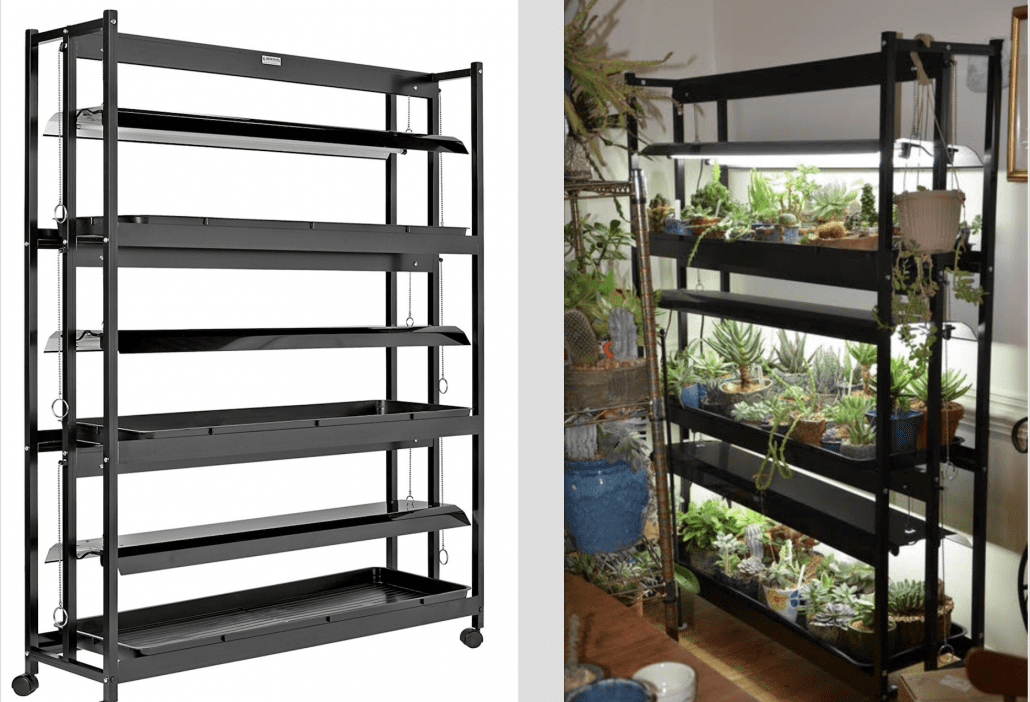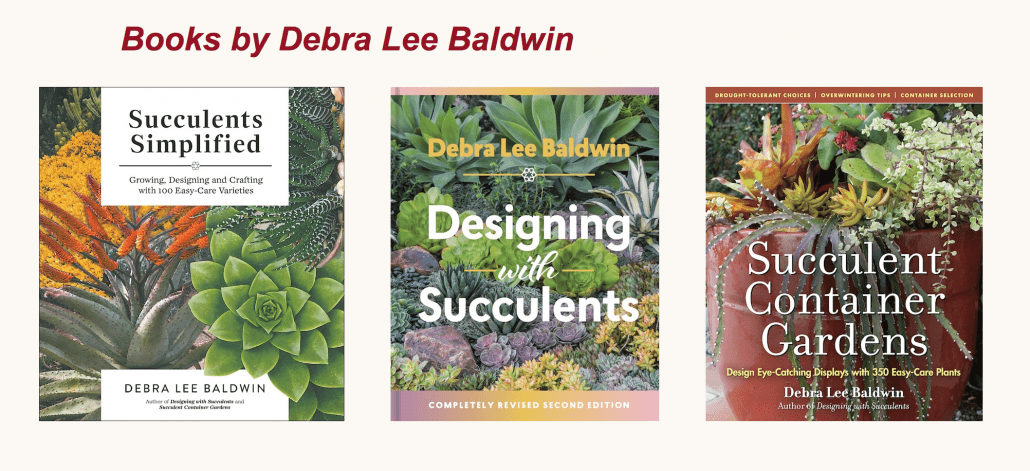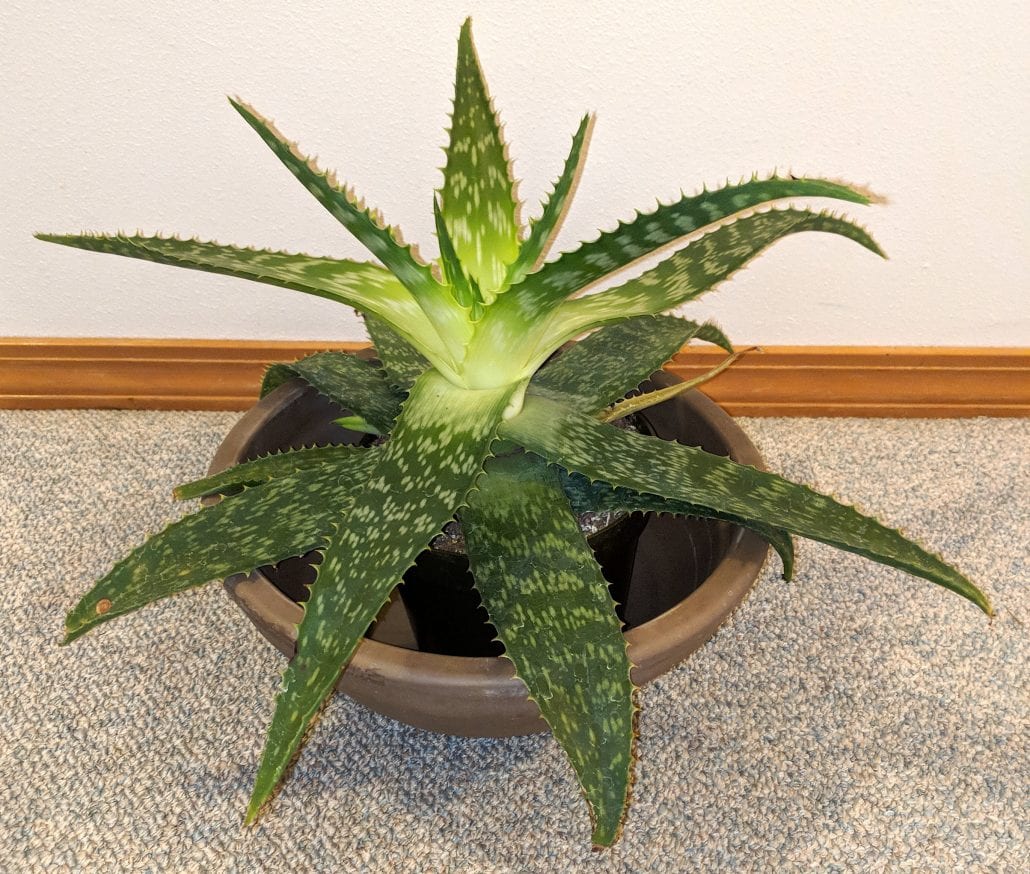From a newsletter subscriber in North Carolina
Q: "Is it possible to grow any succulents in pots in our area? I’m a great fan of succulents and created a gorgeous succulent garden at our home on the West Coast using your books, blogs and website as guidance. Thank you for that! We get a huge amount of rain where we are and are at 3200’ so we do get some snow in winter….. we do have a completely covered patio area where we could put pots but there would be shade."
A: You probably can grow succulents in pots in your covered patio if you turn it into an arid greenhouse. Provide plenty of light (ideally from full-spectrum bulbs that replicate sunlight), keep temperatures above freezing, and provide good air circulation so mealy and other bugs don’t settle in.
Below is the handout sheet for attendees of my Northwest Flower & Garden Festival presentations. ~ Debra Lee Baldwin
Nearly any succulent will grow in northern climates as a windowsill or greenhouse plant.
Your biggest challenge is giving these sunbathers enough light. Indoors, set them near windows that face south or west. Don't bother with north-facing windows, but if your windows face east, do collect and enjoy low-light lovers such as haworthias and gasterias. Tip: Maximize the vertical space near a light source by growing small succulents in hanging pots or globes.
Succulents are light-lovers from regions with low humidity, above-freezing temps, and fewer than 24 inches of rainfall annually.
No matter where you live, protect your succulents from excessive damp and cold, and if growing them indoors, install T-5 bulbs and provide good air circulation. And because succulents really do prefer to be outdoors, take them outside during seasons YOU want to be outside enjoying the fresh air and sunshine!
Seasonal Care
Cultivate succulents native to arid climates (which are the majority) outdoors during warm, sunny months and shelter them indoors during cold, wet months. Most need to be kept above 32 degrees year-round and dry in winter.
Water thoroughly but infrequently.
Waterlogged roots may rot. Don’t use pot saucers. Let soil go nearly dry between waterings. The fatter the succulent, the more camel-like, and the less water it requires. Cacti in particular cannot tolerate overwatering. In winter most succulents go dormant; withhold water unless days are unseasonably warm.
Soil needs to drain quickly and go almost dry between waterings.
Amend garden soil and potting mixes 1/3 to 1/2 with perlite or pumice, or use a commercial cactus mix.
Feeding your plants
Lightly fertilize (half-strength liquid fertilizer) in spring.
Sun
Give at least six hours of light daily, indoors or out, to maintain plant symmetry and color, and to encourage flowering. Protect from intense afternoon sun in summer. See my article: Why Doesn't My Succulent Bloom?
Create an indoor "light island" for overwintering your succulents or if you don't have adequate window light. You'll need multi-shelf wire racks with trays to catch drips. Ready-to-go units often include lights, or install T-5 fluorescent grow lights that stay on for six to eight hours daily (less in winter). Include a fan for air circulation and a timer that switches everything off in the evening and on in the morning.

Above: Made of lightweight, powder-coated aluminum, these indoor plant shelves come with adjustable lights with energy-efficient bulbs; plastic drip trays; and wheels for easy positioning. Provides 18 square feet of growing space. From Gardener’s Supply Co., about $600.
Air circulation is important to prevent insect infestations.
Watch for mealy bugs in leaf axils and aphids on flower buds. Control by spraying with dilute rubbing alcohol.
Temperature
With the exception of sempervivums, jovibarbas, many sedums and yuccas, and certain cacti and ice plants, the majority of succulents are frost-tender. Although they can tolerate temps down to freezing and in excess of 85 (if shaded), between 40 and 80 degrees is ideal.
Overwintering
Echeverias and other rosette succulents are shallow-rooted and can be scooped from garden beds and packed into nursery flats. Provide six hours of light (fluorescent is fine and economical) daily to prevent stretching; store between 35 and 60 degrees; and keep a fan running for air circulation. In spring, reintroduce to strong sunlight gradually lest leaves sunburn.
Mail-order succulents for cold climates
Mountain Crest Gardens sells quality cold-hardy succulents for pots and garden beds at great prices. Some are available in assortments, as solo specimens, bare-root and as cuttings.
Related Info
Books
- Designing with Succulents (2nd ed.) See the section on Cold-Climate Succulent Gardens.
- All my books show design ideas and give care and cultivation for Sedum and Sempervivum.
- The Plant Lover’s Guide to Sedums, by Brent Horvath (Timber Press)
- Cacti & Succulents for Cold Climates, by Leo Chance (Timber Press)
- Hardy Succulents: Tough Plants for Every Climate, by Gwen Kelaidis, Photos by Saxon Holt (Storey Publishing)
- Sempervivum: A Gardener's Perspective of the Not-So-Humble Hens-and-Chicks by Kevin Vaughn
Also on this site
- How to Keep Succulents Happy Indoors Includes a Gallery of Indoor and Shade Succulents
- 50 Succulents that Don't Freeze in Winter What you need to know plus a Photo Gallery of Hardy Succulents
- Showy Succulents for Snowy Climates (Debra's Wall Street Journal Article)
- Overwintering Succulents How to keep succulents happy during cold winter months
- Cold-Weather Care for Outdoor Succulents, By Region Where you live can make a big difference
- Frost and Succulents: What You Need to Know Can succulents recover from frost damage? Find out.
Videos


